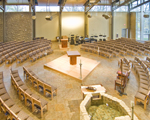Some acoustical environments are straightforward in purpose. A movie theatre, for example, needs to project the sound of the movie with precision and clarity to all seats in the house. Most acoustical environments, however, have varying needs which are dependent on their content and delivery, and the Church is no exception. Today’s churches use a wide variety of forms of aural communication – drama, dance, video, soloists, choirs, the spoken word, and so on. But by far, the two most prominent aural elements in church services are music and the spoken word; two elements that require vastly different (and somewhat conflicting) acoustical environments. Today we will explore the optimal environments for both.
For the performance of traditional church music (choirs, organs, bells, etc.), an acoustically reverberant environment is desirable. A “live” room can deliver a lush, full sound to the attendees as the music fills the sanctuary. For contemporary worship teams with a full band and multiple singers, a good reverberation time needs to be present, but not overly prominent. The band needs to be able to hear itself in order to play in sync, and too much reverberation can result in feedback or distortion. In this case, a controlled reverb is desirable. So, as a general rule, music will sound better when it is performed in an acoustically reverberant environment, and it will sound worse when performed in an acoustically “dead” (or overly absorbent) environment.
The spoken word, on the other hand, needs to be delivered in an acoustically absorbent environment; not a “dead” environment, mind you, but a controlled one. In a less reverberant room, extra reflections of the sound are absorbed, delivering a clean and intelligible message to the audience. However, if the room is too absorbent (resulting in a dull or lifeless sound), acoustical ceiling reflectors can be used to bend the sound and carry it evenly to every seat in the house, and absorption products can be minimized with strategic placement in and around the room.
Again, almost any church service will have elements of music and the spoken word, so it’s our job as independent acoustical consultants to design environments that are versatile enough for both. As engineers, we have to address all aspects of the acoustics, from desired sounds (such as a choir or a sermon) to undesired sounds (such as noise from the HVAC system, or other noise from inside or outside the building). Today’s multifaceted church services need a multifaceted acoustical design in order to deliver the message with clarity and precision. At Acoustics By Design, we work with architects, clergy, and church boards to design sanctuaries that address these complex issues, and we develop designs that fit each church’s unique ministry.
